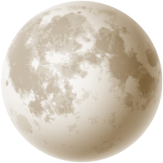


About October's Full Moon
October’s full moon is commonly called the Hunter’s Moon, harkening back to European and Native American traditions where hunters would use the light of the full moon to track down their prey and stock up for the coming winter.
Contrary to popular belief, the Hunter’s Moon isn’t actually bigger or brighter than usual. It simply rises earlier, soon after sunset, which would give hunters plenty of bright moonlight to hunt by during the early evenings. To Neo Pagans, however, the Hunter’s Moon is known by a far more morbid name - the Blood Moon.
Humans through the ages have always found autumn’s full moons to be creepy, and not without good reason. There’s a reason why English folks in the Middle Ages called October’s full moon the Blood Moon, and it’s the exact same reason why even Halloween imagery today often features a large, low-hanging moon with an eerie reddish glow. The Hunter’s Moon rises early in the evening, which means that you are more likely to see it near the horizon. When you observe the moon while it’s near the horizon, it gives off the illusion of being bigger while it’s in fact the same size. In addition, observing the moon at the horizon makes it look redder. This is because you’re seeing it through a thicker atmosphere, which scatters more blue light and lets more red light pass through to reach your eyes.
Scientific explanations aside, the Hunter’s Moon or Blood Moon still holds an undeniable aura of mystique and power. As October’s full moon occurs right before Samhain, the Gaelic mid-autumn festival that has evolved into Halloween today, Neo Pagans consider the month of the Blood Moon to be a special time denoting the change of seasons and a prime opportunity to contact dead loved ones, given the thinning of the veil between the physical world and the spiritual world. Precious stones such as amethyst are used to ward off evil, and sacred flowers like chrysanthemum are used when working with spirits, such as in rituals to commune with long-dead ancestors.
Despite the Blood Moon’s spooky associations, it rarely actually happens on Samhain or Halloween night itself. The next time you’ll get to see the full moon on Halloween is 2020, and if you miss that, you’ll have to wait 15 years to see it in 2035. Sometimes, October’s full moon even happens early enough in the month that it becomes the Harvest Moon, which is defined as the full moon that’s closest to the fall equinox. In Chinese culture, the Harvest Moon is celebrated during the Mid-Autumn Festival, where people gather to celebrate by eating mooncakes. There is also a harvest festival in India that celebrates October’s full moon, called Sharad Purnima. Devotees fast all day before offering delicacies to the Moon God under the moonlight.
In contrast to the day-long fast of India’s moonlight festival, the Hunter’s Moon was a very important feast day in Europe as well as for many Native American tribes. Appropriately, the Ponca tribe’s name for the Hunter’s Moon is “the moon when they store food in caches”. Taking advantage of the fact that the fields have been reaped, hunters would capture foxes and other small animals who come out to graze on the fallen grains, as well as hunt down deer in the moonlight. They would butcher their prey and preserve their meat. Blood Moon is an excellent name for this month’s full moon, given that it was a final, bloody harvesting of meat before the winter months.
Sadly, the tradition of feasting during the Hunter’s Moon was lost around the year 1700, but its spirit still lives on in historical reenactments like the Feast of the Hunter’s Moon, or even the feast of candy enjoyed by trick-or-treaters everywhere on Halloween.




